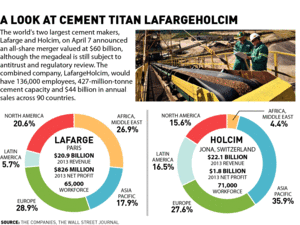
Two of the world's largest cement makers, Lafarge and Holcim, on April 7 announced an all-share merger valued at $60 billion, although the megadeal could take years to close because of antitrust concerns.
The combined company, to be called LafargeHolcim, would have a 427-million-tonne cement capacity, or about 15% of global demand, with 136,000 employees and $44 billion in annual sales across 90 countries.
By capacity, it would bypass China's Anhui Conch Cement Co. as the world's biggest cement producer.
Merger talks began in January as a way to gain more financial leverage against weakened demand, overcapacity and high energy costs. Swiss-based Holcim and France's Lafarge, which have overlapping operations in India, China, Canada and Brazil, would save, after three years, $1.9 billion annually through improved efficiencies, the companies say.
The merger additionally reduces debt accrued after the companies' pricey expansions into emerging markets prior to the global economic crisis. Lafarge paid $12.8 billion in 2008 for Orascom's Cairo-based Cement Group, which followed Holcim's $4.1-billion acquisition of U.K.-based Aggregate Industries in 2005.
"Debt-financed acquisitions have been the bane of many building-materials companies, including Lafarge, in particular," said Chicago-based Morningstar analyst Elizabeth Collins in an investor note. "However, the combined company won't be saddled with massive financial leverage that would limit flexibility."
Cement is the world's second-most consumed material by volume after water. Cheap to make but expensive to transport, its manufacture has long been a local business.
The merger combines Lafarge's strength in Africa and the Middle East with Holcim's presence in Latin America for production facilities in 73 emerging economies.
Those markets will make up 60% of LafargeHolcim sales, with no single country representing over 10%.
The deal has major shareholder support for a 1:1 stock swap, with a 14-person board split equally between the firms. Holcim executive board member Wolfgang Reitzle, a mechanical engineer, would be chairman of the new company; Lafarge Chairman and CEO Bruno Lafont would be CEO.
Holcim investors will own 53% of the new entity, based in Switzerland, with dual listings in Zurich and Paris. The deal is set to close by June 2015, which may be optimistic, analysts say.
"Given the extent of overlap and the number of authorities involved, we continue to see a delay or, at worse, a block on approval," said analyst Robert Muir of Berenberg, London. There is substantial cement-capacity overlap across about 30% of the combined entity's footprint."
LafargeHolcim would have more than 50% market share in eight countries, plus meaningful gains in another 12, Deutsche Bank AB said in an analyst note. The combined firm, which anticipates regulatory hurdles in 15 jurisdictions, plans a $6.85-billion asset sale to gain merger approval, with two-thirds of divestments in western Europe, LafargeHolcim said.
But a "limited number of eligible players will be interested in the assets, so it may be difficult to get full value for required divestments," said analyst Collins.
Both firms are also part of a wide-reaching European Commission cartel probe into price-fixing and market manipulation.
Antitrust scrutiny appears to have torpedoed a smaller supplier sector deal. America's largest paint retailer, Sherwin Williams, on April 4 ended a two-year effort to acquire Mexican rival Consorcio Comex SA after the country's antitrust regulators twice blocked the $2.34-billion offering.
The Cleveland firm's announcement that it had terminated a stock purchase agreement with Comex comes after it bought the Mexican firm's North American businesses last September.
According to coatings sector publication Durability + Design, Mexico's Federal Competition Commission claimed a combined company would have 48% to 58% of regional market share—10 times that of its closest competitor—and ordered it to divest parts of its business. Sherwin-Williams and Comex are now disputing their agreement in a U.S. court.
By contrast, LafargeHolcim would have 88% more cement production capacity than its next closest competitor, enough for nearly 25% of global demand, not including China, with 348 million tonnes in annual aggregate sales.

Post a comment to this article
Report Abusive Comment